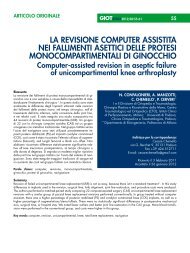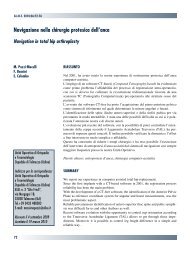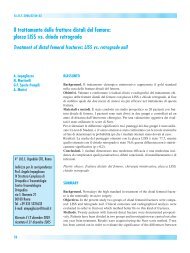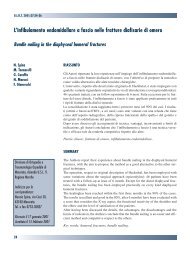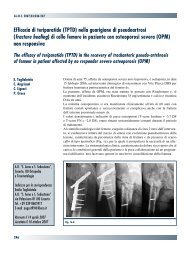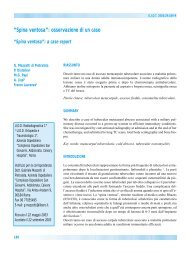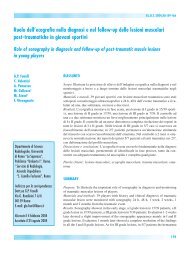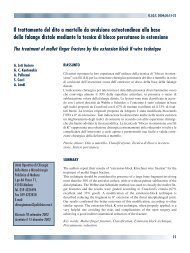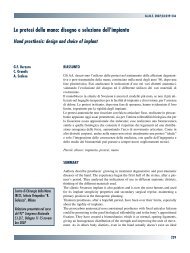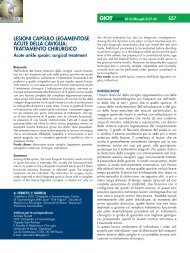Vol.XXXVII, Suppl. 1 - Giornale Italiano di Ortopedia e Traumatologia
Vol.XXXVII, Suppl. 1 - Giornale Italiano di Ortopedia e Traumatologia
Vol.XXXVII, Suppl. 1 - Giornale Italiano di Ortopedia e Traumatologia
Create successful ePaper yourself
Turn your PDF publications into a flip-book with our unique Google optimized e-Paper software.
s108<br />
concLusioni<br />
Dalle nostre osservazioni e dalla letture dei numerosi<br />
lavori conclu<strong>di</strong>amo che le superfi ci rugose migliorano<br />
l’adesione e l’integrazione tra interfaccia e substrato. La<br />
sabbiatura del titanio garantisce una migliore aderenza<br />
ed una minore delaminazione delle superfi ci con una<br />
minore produzione <strong>di</strong> detriti. D’altra parte, i rivestimenti<br />
<strong>di</strong> titanio sabbiato a causa della ruvi<strong>di</strong>tà dell’interfaccia<br />
concedono un aumento della coesione tra l’interfaccia <strong>di</strong><br />
rivestimento ed il substrato. La ricerca della migliore geometria<br />
delle protesi e del materiale più biocompatibile è<br />
continua e molti stu<strong>di</strong> hanno concentrato l’attenzione sui<br />
Bibliografi a<br />
1 Matsusue Y, Yamamuro T, Oka M, et al. In<br />
vitro and in vivo stu<strong>di</strong>es on bioabsorbable<br />
ultra-high-strength poly(L-lactide) rods. J<br />
Biomed Mater Res 1992;26:1553-67.<br />
2 Cochran DL, Schenk RK, Lussi A, et al. Bone<br />
response to unloaded and loaded titanium<br />
implants with a sandblasted and acid-etched<br />
surface: a histometric study in the canine man<strong>di</strong>ble.<br />
J Biomed Mater Res 1998;40:1-11.<br />
3 Thomas KA, Cook S. An evaluation of<br />
variables infl uencing implant fi xation by <strong>di</strong>rect<br />
bone apposition. J Biomed Mater Res<br />
1985;19: 875-901.<br />
4 Wilke HJ, Claes L, Steinemann S. The infl uence<br />
of various titanium surfaces on the interface<br />
shear strength between implants and<br />
bone. In: Heimke G, Soltesz U, Lee AJC, eds.<br />
Advances in biomaterials:clinical implant<br />
materials. Amsterdam: Elsevier Science Publishers<br />
1990, pp. 309-14.<br />
5 Klokkevold, PR, Nishimura RD, Adachi M,<br />
et al. Osseointegration anhanced by chemical<br />
etching of the titanium surface: a torque<br />
removal study in the rabbit. Clin Oral Implants<br />
Res 1997;8:442-7.<br />
6 Buser D, Schenk RK, Steinemann S, et al.<br />
Infl uence of surface characteristics on bone<br />
V. ZottoLa Et aL.<br />
integration of titanium implants. a histometric<br />
study in miniature pigs. J Biomed Mater Res<br />
1991;25:889-902.<br />
7 Weingart D, Steinemann S, Schilli W, et al.<br />
Titanium deposition in regional lymph nodes<br />
after insertion of titanium screw implants in<br />
the maxillofacial region. Int J Oral Maxillofac<br />
Surg 1994;23:450-2.<br />
8 Cochran DL, Simpson J, Weber HP, et al. Attachment<br />
and growth of periodontal cells on<br />
smooth and rough titanium. Int J Oral Maxillofac<br />
Implants 1994;9:289-97.<br />
9 Boyan BD, Batzer R, Kieswetter K, et al. Titanium<br />
surface roughness alters responsiveness of<br />
mg 63 osteoblast-like cells to 1_,25-(oh)2d3.<br />
J Biomed Mater Res 1998;39:77-85.<br />
10 Martin JY, Dean DD, Cochran DL, et al. Proliferation,<br />
<strong>di</strong>fferentiation, and protein synthesis<br />
of human osteoblast-like cells (mg63)<br />
cultured on previously exposed titanium surfaces.<br />
Clin Oral Implants Res 1996;7:27-<br />
37.<br />
11 Hermann JS, Cochran DL, Pirkka V, et al. Crestal<br />
bone changes around titanium implants.<br />
a ra<strong>di</strong>ographic evaluation of unloaded nonsubmerged<br />
and submerged implants in the<br />
canine man<strong>di</strong>ble. J Periodontol 1997;68:<br />
1117-30.<br />
trattamenti <strong>di</strong> sabbiatura della superfi cie degli impianti in<br />
lega <strong>di</strong> titanio. Clinicamente, gli effetti della tecnica operatoria,<br />
il <strong>di</strong>segno dell’impianto e le proprietà dei materiali<br />
hanno un importante effetto biologico sull’integrazione,<br />
sulla durata e sulla stabilità della protesi dal momento<br />
che il trattamento <strong>di</strong> sabbiatura infl uenza la cinematica<br />
che appare essere secondaria alla qualità ed alla quantità<br />
dell’integrazione biologica dell’impianto. Dalla lettura<br />
dei <strong>di</strong>versi stu<strong>di</strong> e dalla nostra esperienza la sabbiatura<br />
della superfi cie <strong>di</strong> un impianto in lega <strong>di</strong> titanio aumenta<br />
la formazione ossea sulle superfi ci e migliora l’adesione<br />
dell’interfaccia paragonabile ai rivestimenti porosi.<br />
12 Arys A. Philippart C. Dourov N. et al. Analysis<br />
of titanium dental implants after failure<br />
of osseointegration: combined histological,<br />
electron microscopy, and X-ray photoelectron<br />
spectroscopy approach. J Biomed Mater<br />
Res1998;43:300-12<br />
13 Wong M, Eulenberger J, Schenk RK, et al. Effect<br />
of surface topography on the osseointegration<br />
of implant materials in trabecular bone. J<br />
Biomed Mater Res 1995;29:1567-75.<br />
14 Buser D, Nyddeger T, Oxland T, et al. The<br />
interface shear strength of titanium implants<br />
with a sanblasted and acid-etched<br />
surface. a biomechanical study in the maxilla<br />
of miniature pigs. J Biomed Mater Res<br />
1999;32:1657-755.<br />
15 Wilke HJ, Claes L, Steinemann S. The infl uence<br />
of various titanium surfaces on the interface<br />
shear strength between implants and<br />
bone. In: Heimke G, Soltesz U, Lee AJC, eds.<br />
Advanced in biomaterials: clinical implant<br />
materials. Amsterdam: Elsevier Science Publishers<br />
1990, p. 309-14.<br />
16 Aronsson B-O, Hjörvarssojn B, Frauchiger L,<br />
et al. Hydrogen desorption from sand-blasted<br />
and acid-etched titanium surfaces after<br />
glow-<strong>di</strong>scharge treatment, J Biomed Mater<br />
Res 2001;54:20-9.



